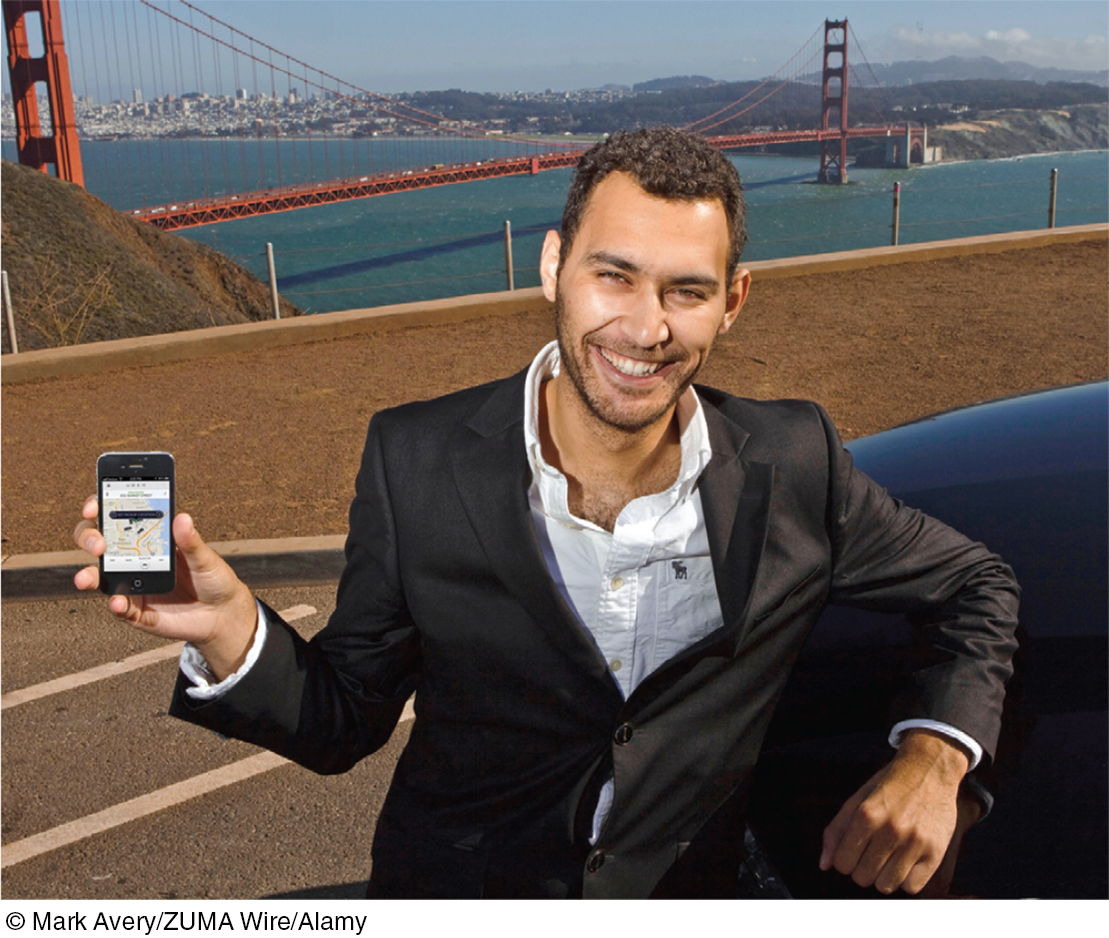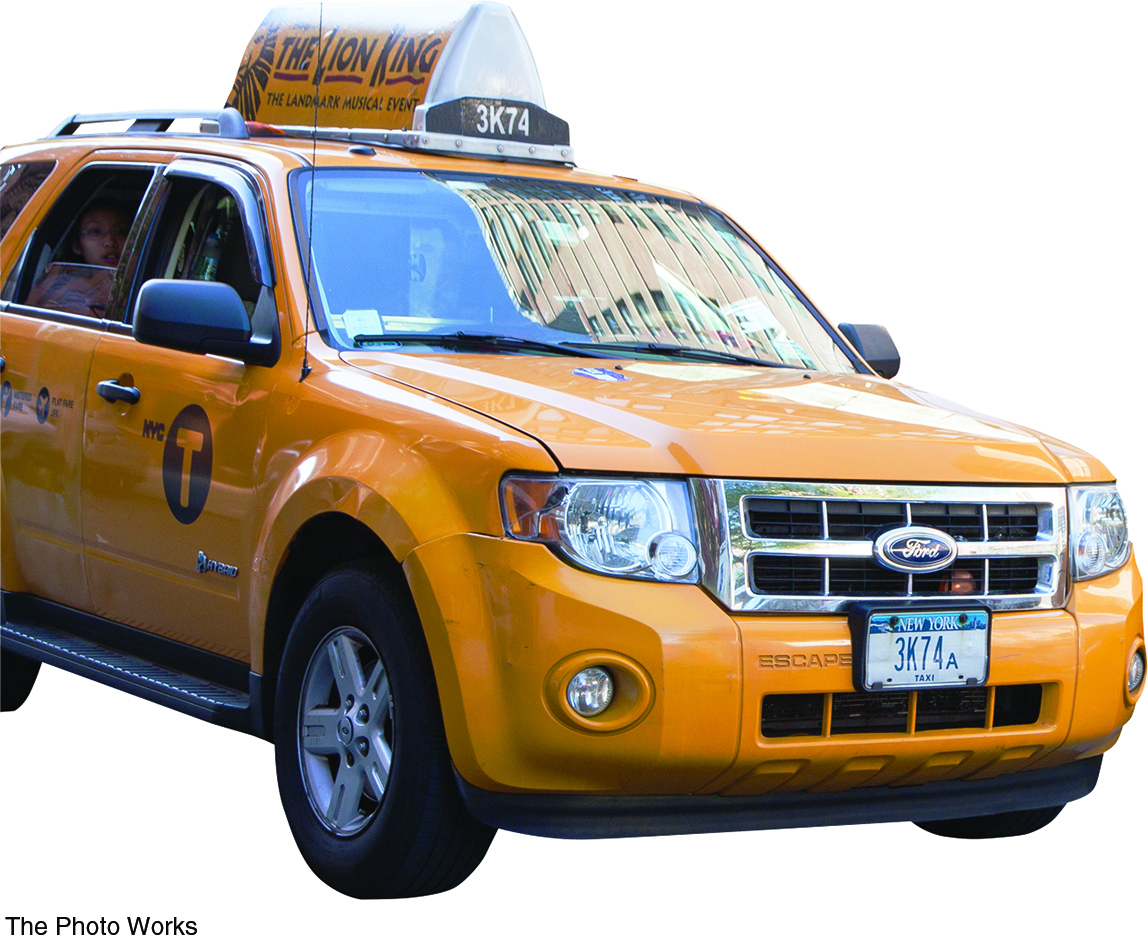5.11 Business Case
BUSINESS CASE
172
BUSINESS CASE
An Uber Way to Get a Ride
In a densely populated city like New York City, finding a taxi is a relatively easy task on most days—

But at times it is not so easy to find a taxi—
In 2009 two young entrepreneurs, Garrett Camp and Travis Kalanick, founded Uber, a company that they believe offers a better way to get a ride. Using a smartphone app, Uber serves as a clearinghouse connecting people who want a ride to drivers with cars who are registered with Uber. Confirm your location using the Uber app and you’ll be shown the available cars in your vicinity. Tap “book” and you receive a text saying your car—
Given that Uber provides personalized service and better quality cars, their fares are somewhat higher than regular taxi fares during normal driving hours—a situation that customers seem happy with. However, the qualification during normal driving hours is an important one because at other times Uber’s rates fluctuate. When a lot of people are looking for a car—
But according to Kalanick, the algorithm that Uber uses to determine the surge price is set to leave as few people as possible without a ride, and he’s just doing what is necessary to keep customers happy. As he explains, “We do not own cars nor do we employ drivers. Higher prices are required in order to get cars on the road and keep them on the road during the busiest times.” This explanation was confirmed by one Uber driver who said, “If I don’t have anything to do and see a surge price, I get out there.”
QUESTIONS FOR THOUGHT
Before Uber, how were prices set in the market for rides in New York City? Was it a competitive market?
What accounts for the fact that during good weather there are typically enough taxis for everyone who wants one, but during snowstorms there typically aren’t enough?
How does Uber’s surge pricing solve the problem described in the previous question? Assess Kalanick’s claim that the price is set to leave as few people possible without a ride.
173
BUSINESS CASE
BUSINESS CASE
Medallion Financial: Cruising Right Along
Back in 1937, before New York City froze its number of taxi medallions, Andrew Murstein’s immigrant grandfather bought his first one for $10. Over time, the grandfather accumulated 500 medallions, which he rented to other drivers. Those 500 taxi medallions became the foundation for Medallion Financial: the company that would eventually pass to Andrew, its current president.

With a market value of $385 million in late 2013, Medallion Financial shifted its major line of business from renting out medallions to financing the purchase of new ones, lending money to those who want to buy a medallion but don’t have the sizable amount of cash required to do so. Murstein believes that he is helping people who, like his Polish immigrant grandfather, want to buy a piece of the American dream.
Andrew Murstein carefully watches the value of a New York City taxi medallion: the more one costs, the more demand there is for loans from Medallion Financial, and the more interest the company makes on the loan. A loan from Medallion Financial is secured by the value of the medallion itself. If the borrower is unable to repay the loan, Medallion Financial takes possession of his or her medallion and resells it to offset the cost of the loan default. Over the past two decades, the value of a medallion rose 720%, compared to 500% for an index of stocks.
But medallion prices can fluctuate, threatening profits. In a very strong economy, such as in 1999 and 2001, the price of New York taxi medallions fell as drivers found jobs in other sectors. When the New York economy tanked in the aftermath of 9/11, the price of a medallion fell to $180,000, its lowest level in 12 years. In 2004, medallion owners were concerned about the impending sale by the New York City Taxi and Limousine Commission of an additional 900 medallions. As Peter Hernandez, a worried New York cabdriver who financed his medallion with a loan from Medallion Financial, said at the time: “If they pump new taxis into the industry, it devalues my medallion. It devalues my daily income, too.”
Yet Murstein has always been optimistic that medallions would hold their value. He believed that a 25% fare increase would offset potential losses in their value caused by the sale of new medallions. In addition, more medallions would mean more loans for his company.
In 2013, Murstein’s optimism was justified. Because of the financial crisis of 2007–2009, many New York companies cut back the limousine services they ordinarily provided to their employees, forcing them to take taxis instead. As a result, the price of a medallion nearly doubled, from $550,000 in 2008 to more than a million dollars in 2013.
But two years later, in 2015, medallion owners watched prices fall to under $700,000. This time, increased competition from Uber and companies like it was to blame. That same year, the market value of Medallion Financial fell by 50%, to $190 million.
QUESTIONS FOR THOUGHT
How does Medallion Financial benefit from the restriction on the number of New York taxi medallions?
What will be the effect on Medallion Financial if New York companies resume widespread use of limousine services for their employees? What is the economic motivation that prompts companies to offer this perk to their employees? (Note that it is very difficult and expensive to own a personal car in New York City.)
Predict the effect on Medallion Financial’s business if New York City eliminates restrictions on the number of taxis. That is, if the quota is removed.
BUSINESS CASE
174
BUSINESS CASE
The Airline Industry: Fly Less, Charge More
The airline industry is forecast to earn nearly $25 billion in profits in 2015, up from nearly $12 billion in 2013. But in 2008, the industry was teetering on the edge of disaster. According to the International Air Transport Association, the industry lost $11 billion that year. However, by 2009, despite the fact that the economy was still extremely weak and airline traffic was still well below normal, profitability began to rebound. And by 2010, despite continued economic weakness, the airline industry had definitely recovered, achieving an $8.9 billion profit that year.

How did the airline industry achieve such a dramatic turnaround? Simple: fly less and charge more. In 2011, fares were 8% higher than they had been the previous year and 17% higher compared to 2009. Flights were more crowded than they had been in decades, with fewer than one in five seats empty on domestic flights. And that trend continues today.
In addition to cutting back on the number of flights—
It doesn’t stop there. As every beleaguered traveler knows, airlines have tacked on a wide variety of new fees and increased old ones—
But industry analysts question whether airlines can manage to maintain their currently high levels of profitability. In the past, as travel demand picked up, airlines increased capacity—
QUESTIONS FOR THOUGHT
How would you describe the price elasticity of demand for airline flights given the information in this case? Explain.
Using the concept of elasticity, explain why airlines would create such great variations in the price of a ticket depending on when it is purchased and the day and time the flight departs. Assume that some people are willing to spend time shopping for deals as well as fly at inconvenient times, but others are not.
Using the concept of elasticity, explain why airlines have imposed fees on things such as checked bags. Why might they try to hide or disguise fees?
Use an elasticity concept to explain under what conditions the airline industry will be able to maintain its high profitability in the future. Explain.